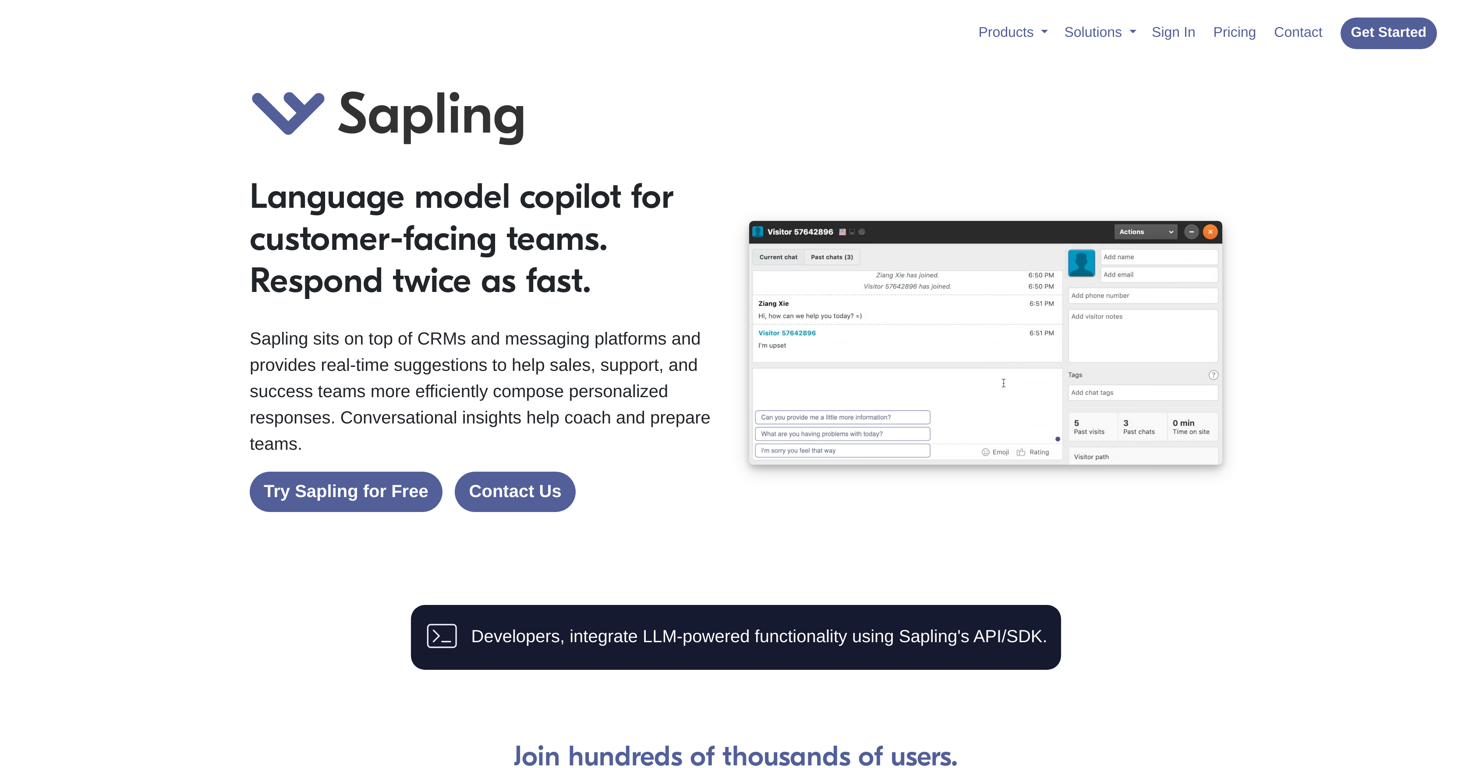What is the purpose of Sapling's snippet library and text expansion shortcuts/macros?
Sapling's snippet library and text expansion shortcuts/macros are tools aimed at optimizing knowledge distribution within teams. They allow instant insertion of common responses across web applications, enabling fast search, compliance, upselling, training, and onboarding. By utilizing these tools, teams can respond to customer inquiries more efficiently.
How does Sapling handle data encryption and security issues?
Sapling includes robust security measures such as Transport Layer Security (TLS) and Advanced Encryption Standard (AES-256) data encryption for protecting confidential information. It also offers Personal Identifiable Information (PII) redaction and self-hosted/on-premises deployment options that further ensure the security and privacy of users' data.
What is Sapling's process for end-user identity management?
Sapling's approach to end-user identity management includes options for Single Sign-On (SSO), System for Cross-domain Identity Management (SCIM), and Multi-factor Authentication (MFA). These features aim at strengthening the user authentication process and safeguarding data from unauthorized access.
How simple is it to install and use Sapling?
Sapling ensures a quick and simple installation process requiring just two clicks to install and deploy. The onboarding process typically takes less than 10 minutes, and it boasts more than a 90% adoption rate among teams.
What benefits can customer-facing teams expect from using Sapling?
Customer-facing teams can expect a variety of benefits from using Sapling. These include improved and optimized omni-channel customer experience, higher-quality professional messaging, faster response and handle time, and improved customer satisfaction. With conversation insights, managers can coach and prepare teams more efficiently while improving language quality and overall efficiency.
How does Sapling integrate with popular messaging and CRM platforms?
Sapling integrates with popular messaging and CRM platforms to deliver its services. This compatibility ensures seamless operation across teams’ web tools like ServiceNow, Salesforce, Zendesk, Amazon Connect, and Twilio Flex.
What components does the Sapling Language Model Copilot offer to assist customer-facing teams?
The Sapling Language Model Copilot offers features like real-time suggestions and integrates with CRMs and messaging platforms to help compose personalized, efficient responses. It offers Sapling Suggest™ for swift response retrieval, and Autocomplete Everywhere™ for quick response composition. It also includes a language and grammar quality tool, which uses machine learning to ensure professional and consistent communication.
What functions does the Sapling API/SDK allow developers to incorporate and how can this be beneficial?
The Sapling API/SDK allows developers to integrate Sapling's language learning model functionalities into their systems or apps. This can be beneficial in providing features such as Sapling Suggest and Autocomplete Everywhere within their own platforms, enabling faster and efficient responses tailored to customer interactions.
How does Sapling empower agents to respond to customer inquiries swiftly?
Sapling empowers agents to respond swiftly to customer inquiries via Sapling Suggest™. It retrieves relevant responses from a team's response bank in real-time, allowing agents to quickly select and send these responses to customers, thus reducing response time and boosting efficiency.
How does Sapling ensure professional and consistent communication?
Sapling ensures professional and consistent communication through its language and grammar quality tool. The tool which utilizes machine learning trained on millions of English sentences, catches and corrects 60% more language quality issues than other spell and grammar checkers.
In what ways does Sapling provide conversational data insights?
Sapling provides conversational data insights through its natural language processing feature. It allows for automated quality scoring across all conversations, topic and trend monitoring, reporting on usage and efficiency gains at the agent and team level, and significantly reduces the time needed for manual inspection.
What advanced features ensure enterprise security with Sapling?
Sapling's advanced features for enterprise security include TLS and AES-256 data encryption, redaction of personally identifiable information, and self-hosted/on-premises deployment options. All these features work together to ensure that the user's data is secure and that compliant data handling is maintained.
What tools does Sapling offer for end-user identity management?
Sapling offers Single Sign-On (SSO), System for Cross-domain Identity Management (SCIM), and Multi-Factor Authentication (MFA) as tools for end-user identity management. These mechanisms strengthen the security features of the platform by providing an additional layer of verification and identity management.
How does Sapling enhance productivity for customer-facing teams?
Sapling enhances productivity for customer-facing teams through its features like Sapling Suggest™ and Autocomplete Everywhere™. These features help in reducing response times and handle times, therefore improving the overall efficiency and effectiveness of customer interactions. It also facilitates knowledge sharing through a snippet library and text expansion shortcuts.
How does Sapling's natural language processing capability help with customer conversations?
Sapling uses natural language processing to distil insights from customer conversations. This functionality enables automated quality scoring of teams and agents, reporting on usage and efficiency gains, and topic and trend monitoring for rapid adjustments to issues. These insights can be used to inform strategies, improve customer interaction, and enhance service efficiency.



